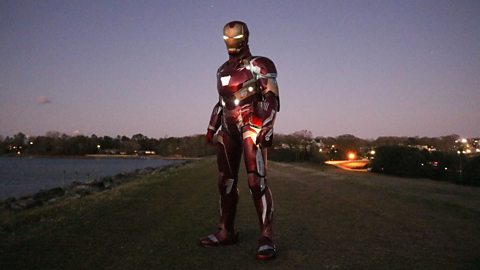 Image source, Emily Yarid
Image source, Emily YaridMy name is Emily, and I went viral on TikTok for 3D printing full size, wearable Iron Man suits!
As a recent mechanical engineering graduate, Iтve loved getting to learn more about 3D printing at college. Iтve printed two whole Iron Man suits, and I typically post my progress on social media platforms like Instagram, TikTok and YouTube.
One of my videos went viral on TikTok, accumulating over 70 million views and five million likes. As a result, I now have two and a half million followers and counting.
 Image source, Emily Yarid
Image source, Emily YaridTaking inspiration from a superhero
When I first got to college, actually owning a 3D printer was a fairly foreign concept to me. It blew my mind to learn that my university had a whole space set aside for them. Being a huge Marvel fan, when I was finally given the opportunity to make anything my mind could come up with, the obvious choice was an Iron Man helmet.
Little did I know, this one small project would lead to a whole new world of learning how 3D printers work and would introduce me to a new hobby, bringing fictional props, costumes, or tools to life.
Iтve been a pretty big Marvel fan for quite a while now. Tony Stark has definitely always been my favourite character within the Marvel universe, mainly because he has absolutely zero powers. He only has his brain, yet heтs able to build and do the things he can.
 Image source, Emily Yarid
Image source, Emily YaridI had previously, at the age of 14, made an Iron Man suit out of foam and hot glue, but after learning about all of the things that were possible with 3D printing, I purchased my first printer in my junior year of college and decided to kick it up a notch.
I created my first printed suit in 2019. It was insanely entertaining to build, and people seemed to get a kick out of me wearing it.
However, when you spend so long making something, by the end of the process you already have ideas on how to improve next time. With the beginning of quarantine starting in March 2020, I realized I had some time on my hands. So I decided to move forward and create another suit: one that was more mobile and had more motorized parts than the previous one.
One of the biggest motivators in hobbies like this is envisioning the end result. If you have something you would love to see exist in real life, chances are it can be achieved with 3D printing, a little bit of patience, and dedication.
 Image source, Emily Yarid
Image source, Emily YaridHow a 3D printer works
There are different types of 3D printers, with the most popular and affordable being FDM printers (Fused Deposition Modeling). FDM 3D printers are capable of taking spools (cylinders) of plastic, and creating unique structures by pulling the plastic in, melting it, and distributing it.
Apart from FDM, there are also resin printers (SLA or DLP). Resin is a type of plastic that typically starts out as a liquid. It then cures to result in a tough, rigid plastic. Curing is the hardening process that resin undergoes when, in the case of a resin printer, the material is exposed to UV light. A resin printer creates objects out of baths of resin which is then cured layer by layer to achieve a final result.
In my case, I used FDM printers to create my Iron Man suits due to their large size.
[Remember to always follow any instructions and health and safety advice from the 3D printer manufacturer.]
Getting to grips with computer software
One of the biggest misconceptions about 3D printing, is that you need to be skilled in computer modelling in order to get started. Many files for pre-existing 3D models can be found on the internet and downloaded to be printed. If youтre wondering how youтd get a 3D model from your computer over to the printer itself, itтs not actually that complicated! Thankfully we have software that does the processing for us.
If you have a 3D model of something that you want to print, you can throw that file into a piece of software [from a reputable source] that we call a тslicerт. In the slicer, you can digitally cut apart large files into smaller pieces, to fit on any machine. Additionally, you can orient your part correctly and alter thicknesses and fine details; then the program can translate this into a code that the printer understands. This is referred to as тG-codeт. The G-code tells the printer how to move and where specifically to distribute plastic, layer by layer, until the entire part is made.
In order to make super precise pieces, these layers are typically less than half a millimetre in height. This means that a print can take anywhere from a few minutes, to a couple days depending on how large or small. It also means that a lot of detail can be captured by 3D printers as well.
 Image source, Emily Yarid
Image source, Emily Yarid Image source, Emily Yarid
Image source, Emily YaridHow to get started in 3D printing
If youтre interested in getting started with 3D printing, I would say the first step would be to get your hand on a printer! Several schools, universities, and businesses have them, and gaining access to them may be easier than you think.
The other option is to get one for yourself. Like I mentioned earlier, before I got involved in this hobby, I saw that as a completely foreign concept. However, printers are a lot more affordable and accessible than people would tend to believe.
After getting your hands on a printer, and downloading a slicer software the skyтs the limit. Whether you start big or small is up to you. Either way you will learn a lot! There are plenty of online resources and forums as well to help with troubleshooting, and any questions you have along the way.
Over the years, Iтve gone from being a member of these communities to helping other people learn. I just so happened to have a desire to print full wearable Iron Man suits, but the options with 3D printing are limitless.
 Image source, Emily Yarid
Image source, Emily YaridWhatтs it like to be тcottagecoreт?
We spoke to cottagecore influencer, writer and stylist Paula Sutton about the reality v the aesthetic.

What is WitchTok, and how does a WitchTokker prepare for Halloween?
Halloween is a magical time of year for some people, in more ways than one.

The marvellous universe of diverse superheroes
We take a look at LGBTQ+, Indigenous and anime superheroes.
